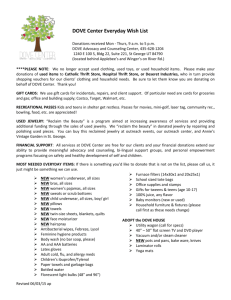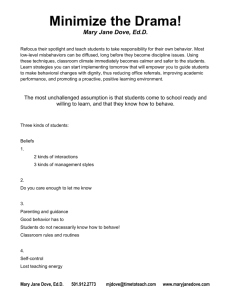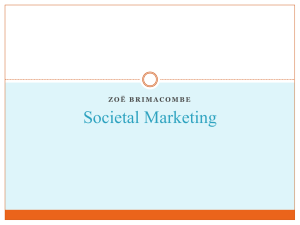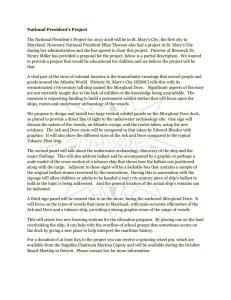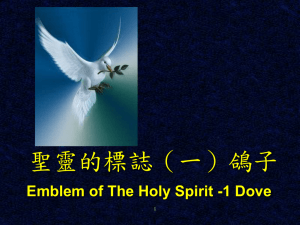William Dove (1354), Index
advertisement
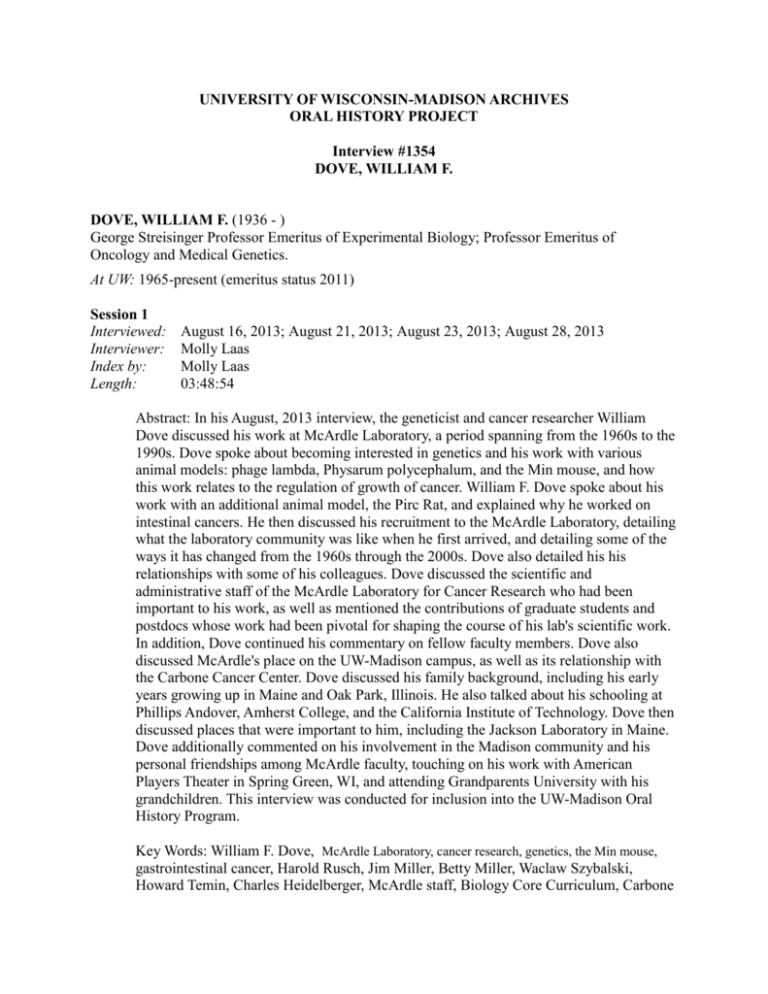
UNIVERSITY OF WISCONSIN-MADISON ARCHIVES ORAL HISTORY PROJECT Interview #1354 DOVE, WILLIAM F. DOVE, WILLIAM F. (1936 - ) George Streisinger Professor Emeritus of Experimental Biology; Professor Emeritus of Oncology and Medical Genetics. At UW: 1965-present (emeritus status 2011) Session 1 Interviewed: Interviewer: Index by: Length: August 16, 2013; August 21, 2013; August 23, 2013; August 28, 2013 Molly Laas Molly Laas 03:48:54 Abstract: In his August, 2013 interview, the geneticist and cancer researcher William Dove discussed his work at McArdle Laboratory, a period spanning from the 1960s to the 1990s. Dove spoke about becoming interested in genetics and his work with various animal models: phage lambda, Physarum polycephalum, and the Min mouse, and how this work relates to the regulation of growth of cancer. William F. Dove spoke about his work with an additional animal model, the Pirc Rat, and explained why he worked on intestinal cancers. He then discussed his recruitment to the McArdle Laboratory, detailing what the laboratory community was like when he first arrived, and detailing some of the ways it has changed from the 1960s through the 2000s. Dove also detailed his his relationships with some of his colleagues. Dove discussed the scientific and administrative staff of the McArdle Laboratory for Cancer Research who had been important to his work, as well as mentioned the contributions of graduate students and postdocs whose work had been pivotal for shaping the course of his lab's scientific work. In addition, Dove continued his commentary on fellow faculty members. Dove also discussed McArdle's place on the UW-Madison campus, as well as its relationship with the Carbone Cancer Center. Dove discussed his family background, including his early years growing up in Maine and Oak Park, Illinois. He also talked about his schooling at Phillips Andover, Amherst College, and the California Institute of Technology. Dove then discussed places that were important to him, including the Jackson Laboratory in Maine. Dove additionally commented on his involvement in the Madison community and his personal friendships among McArdle faculty, touching on his work with American Players Theater in Spring Green, WI, and attending Grandparents University with his grandchildren. This interview was conducted for inclusion into the UW-Madison Oral History Program. Key Words: William F. Dove, McArdle Laboratory, cancer research, genetics, the Min mouse, gastrointestinal cancer, Harold Rusch, Jim Miller, Betty Miller, Waclaw Szybalski, Howard Temin, Charles Heidelberger, McArdle staff, Biology Core Curriculum, Carbone William F. Dove (#1354) Cancer Center, Jackson Laboratory, Madison, WI, Interview Session (August 16, 2013): Digital File Time Keywords 00:00:00 Start of Interview/Interviewer’s Introduction. 00:00:13 Question: How did William Dove (WD) become interested in genetics? Answer: WD noted as a preamble that history itself is a fiction; a story that we tell ourselves to make sense of the past. WD described his research career as opportunistic. He had been interested in physical chemistry since high school and loved working in chemistry lab and making compounds. WD learned how to do research in graduate school at Caltech [received PhD there in 1962]. The question that intrigued him there were the behavior of molecules. WD noted that Caltech was a small research community and due to this he was able to work with molecular biologist Max Delbrück, who had gathered around him people from many different backgrounds to work on biological problems. WD did experiments in the Delbrück lab while doing his chemistry PhD, and in this capacity he was exposed to genetics and learned to analyze biological problems. As a postdoc [at the Medical Research Council Unit for Molecular Biology at the University of Cambridge, 1962-63] he learned how to use genetic techniques. 00:04:49 [No question] WD described chemistry as synthesis, a bottom-up understanding of the molecule. By contrast genetics as he learned it as a postdoc is top-down; taking a working biological system and asking which mutations interfere in the process, by subtracting one element at a time. The intent is to identify the genes that are involved in the process. In his case, DNA replication of a simple virus [phage lambda]. Do these two approaches meet, and encounter the same molecule? WD said that the great bridge between molecule-builders and geneticists is the mutated gene. When a gene is mutated it is possible to find out by sequencing it what protein does it code for, and how it changes when you interrupt the system. When you do biochemistry you find that the same protein is a central part of a system you build from scratch. This approach has been successful, depending on biochemists who use genetics. This gives them the confidence that a molecule they purify is part of the system. 00:09:03 Question: Did WD work with Linus Pauling at Caltech? Answer: Yes. WD said that Pauling was the éminence grise of the Caltech chemistry department at that time. Pauling has brought undergraduates from England to work on a pet project, and WD supervised them, as he had finished his PhD and had time. WD said he could see the intuitive brilliance that Pauling brought to science, and his command of chemistry, as well as his distance from hands-on experimental work as he became more involved in public affairs and other projects. WD said that the project that he worked on had to do with the action of general anesthetics. 00:12:30 Question: Regulation of growth is an overarching theme in WD's research career. William F. Dove (#1354) What led him to be interested in this question? Answer: WD talked about influence of the person who became his mentor at MRC-Cambridge. He was first assigned to Francis Crick, who was trying to fill in gaps of understanding the genetic code using biochemical binding experiments that would figure out what amino acid a particular triplet code coded for. WD said that these experiments did not excite him. Talks about the work of Sydney Brenner, a Cambridge biologist who understood the genetics. Brenner became interested in the control of replication in 1963, while Dove was a postdoc. He published a paper with the French geneticist François Jacob on the replicon model for DNA replication. Dove wanted to test it, though it was difficult to figure out how to test it. WD talked about phage lambda, [a bacterial virus] that can infect a host genome but live passively – it does not kill the host, though it is replicated by the host. WD said he selected for viruses that could not grow. WD digressed a bit to note that issues of latency versus active growth is rampant throughout current McArdle research. In his own lab, work is being done on early stages of colon cancer that become latent. Dove says that he studied this intensively in phage lambda in the early 1960s. WD notes that this shows the influence of Brenner and Jacob on his work. He and his wife Alexandra Dove worked in Jacob's lab at the Pasteur Institute in Paris in 1975-6, in order to learn new scientific methods for studying mammalian differentiation. Studying how a virus replicates or doesn't replicate came out of his postdoctoral work, using genetics to analyze a complicated system. 00:20:55 [No question.] Dove explained that this was a time when biochemists, most notably Arthur Kornberg (Stanford biochemist), were trying to use purified enzymes to build systems for DNA replication for the host E. coli. WD said that the biochemistry department at Stanford gave him a lab to work in after he had accepted a position at McArdle, as his lab in Madison was not yet finished. There he became familiar with Kornberg's science and the culture of the Stanford biochemistry department. By then, WD said he was committed to genetic analysis, and every time Kornberg would talk about the purified Kornberg polymerase WD would ask whether he knew if it was involved in DNA replication. WD related an anecdote about Kornberg using biochemical methods as well as genetic ones to solve a problem in DNA replication. WD said that the purified approach of the chemist seldom works; genetic methods are needed to find out which molecules are important. Dove said that his work with replication and lambda identified its process of replication. The molecular detail came in part from Fred Blattner's work (professor of genetics at UW-Madison, former postdoc of Waclaw Szybalski). He was one of the first to make DNA sequencing feasible for small genomes, like lambda and E. coli, in the early 1970s. WD said that his lab collaborated with Blattner. Dove noted that much of his work has involved the graduate students who worked in his lab and the McArdle community. WD notes that it was impossible to know when he joined the faculty (in the mid-1960s) that he could do genetics work on anything more complicated than a simple virus. When Harold Rusch hired WD, he knew that his work had affinities with Howard Temin's work. 00:29:42 Question: [How did WD make a shift from working on a virus to working on the slime mold model [Physarum polycephalum]? Answer: By the 1970s, DNA William F. Dove (#1354) sequencing could be done on more complicated organisms, such as yeast and various microbial eukaryotes. Dove said that physarum has euykariotic nuclei and presents mitotic cycle in an amplified way. Rusch had perfected ways to grow physarum, and WD and his first graduate student, Finn Haugley began to work on the organism because of its synchronous replication cycle. WD explained his research on the organism, noting the contributions of Tim Burlent, an assistant scientist in the Dove lab, Tim Schedl, a graduate student in molecular biology, and Keith Gull, sabbatical visitor from England. The group was able to study molecular processes that happen during the mitotic cycle and how the microtubular system shows very dramatic regulation in anticipation of the mitosis, then inactivates itself when it is complete. WD said that they were able to analyze this in molecular detail and study the effects of anti-microtubular drugs that are used in cancer therapy. 00:36:03 Question: How did your work on physarum relate to cancer research? Answer: Dove said that if a simple definition of cancer is that it's uncontrolled replication. To begin to understand cancer at a basic level, Dove and his lab wanted to understand how cancers replicate. His lab studied one aspect of it; the mitotic apparatus. Dove said that ideas are like a seed, but they need a soil to flourish, either a receptive colleague or a community. Dove said that what they did with lambda and physarum was in a culture that was thinking about cancer. He said that even in the 1960s he had pressure from senior scholars to do his genetics on mammalian cells. He knew that the genetics of mammalian cells was not rational, in that the ploidy was not controlled. So the genetics could not be mapped and had a large ascertainment bias. He thought he could do better work on lambda and physarum. Dove noted that his stint in Jacob's lab gave him the tools for working on mammalian genetics. WD said that he talked with Peter Brooks, a visiting scholar in Charles Heidelberger's laboratory, about carcinogens and how they act. It became clear to WD in the late 1970s that there was a class of carcinogens, the nitrosamines, that would be effective mutagens in the germ line. Bill Russell and the large mutagenesis facility at Oak Ridge had studied the same class of molecules. One of these nitrosamines was found to be active, so WD said that they knew that they could approach mammalian biology with rational genetic methods. Alexandra wanted to get into serious research in the late 1970s. So to make mutagenesis work it takes calendar time, as WD put it, as the progress of the experiment is staged by the life cycle of a lab animal. Alexandra would see her animals every day, when she had time to to do it. This gave the lab time to develop mutations in the mouse that were effective in differentiation. The byproduct of this was the first mouse mutant that in the germ line developed intestinal cancer. This is the mid-1980s. [Dove referred to the Min Mouse] 00:45:00 Question: What are some of the applications of the Min Mouse? Answer: WD said that they were able to study all of the genes that affect the process of tumor formation. He explained that there can be several genes in a system that tip the balance toward the development of cancer, or slow or speed up development of cancer. Dove detailed the modifer gene his lab identified that slows the growth rate of cancers. This, combined with other modifying loci in the genome, can stop cancer growth. WD also described research on cloned HeLa cells that suggests ways that therapies could William F. Dove (#1354) interfere with the early stages of a tumor, as well as early detection of cancers. Dove noted that his lab worked with the Jackson Laboratory at Johns Hopkins University in 1993 making the Min mouse available to researchers around the world with no restrictions. Many hundreds of publications have been made using the Min mouse over the past 20 years using animals from the Jackson Lab. Dove notes that this is a strong contrast with the OncoMouse, licensed by Harvard University to DuPont, which put strong restrictions on its use and limited publications. Dove said he was lucky to work with WARF, which supported making strains available worldwide. Dove noted that there has been a lot of research on cancer but that they only treatment available is 5-fluorouracil, developed at McArdle by Heidelberger. One must believe that early detection is the best way to address colon cancer as a public health problem, which is why his lab works on early detection. 00:54:16 End of Interview Interview Session (August 21, 2013): Digital File Time Keywords 00:00:00 Start of Interview/Interviewer’s Introduction. 00:00:11 Question: Why did Dove decide to create the Pirc Rat? Answer: William Dove [WD] explained that some organisms show biological phenomena more clearly than others. The Min Mouse was useful for cancers in the small intestine. However, changes in the same gene that causes small intestine cancer in the Min Mouse causes colon cancer in humans. WD noted that McArdle scientists Henry Pitot and Michael Gould studied rats; in addition, Alexandra Dove and others in the Dove group had made germ-line mutagenesis practical. Gould used these techniques in rats. The Dove lab collaborated with Gould's mutagenesis program, and they monitored the animals that emerged from his program for genes that would be useful for them. Dove said that his graduate student Larry Kwong and postdoc Jim Amos-Landgraf set up a screen for a mutation in the rat that affected a gene called APC. They looked at over 1,300 rats over the period of a year, and found an animal that had a mutation in this gene. They found that the mutation led to colon tumors, like the human. WD said that they were then able to develop a number of experiments for which the rat is more suitable than the mouse. WD notes that the genetics of the mouse is highly developed as a tool for doing genetics research; by contrast the rat is less developed, but is beginning to catch up. For the Dove lab the most important thing is the initial biology: a defect in this particular gene gives a human-like disease. A mouse does not behave that way. 00:08:20 Question: Did Dove work out a similar means of sharing the Pirc Rat with colleagues as he did with the Min Mouse? Answer: WARF got a patent for the Pirc Rat. The Min Mouse was developed in collaboration with a group from Johns Hopkins, and they were working with the pharmaceutical company Hoffman-La Roche, which wanted to patent it. Dove said that his lab and his Hopkins colleagues did not think it would be beneficial to patent it. This allowed the Jackson Laboratory to make the Min Mouse freely available to academic researchers. WARF has licensed the Pirc Rat to Taconic William F. Dove (#1354) [a lab mouse and rat supplier] under a similar open access model as the Min Mouse for academic researchers. Dove notes that the McArdle rat cancer genetics community now includes James Shull. 00:11:56 Question: Why study gastrointestinal cancers? Answer: The Min model was the first to emerge from mutagenesis experiments. That being said, Dove noted that gastrointestinal cancer is the second-most prevalent cancer in the industrialized world. The survival rate for the cancer is about 50%, he added. Most of what Dove's lab does with the Pirc Rat is to work on early detection of cancer. Some of their investigations have been with the biotechnology center to look for markers that might be present in blood to be used for early detection of cancer. An early tumor can be surgically removed, Dove noted, which is a less-risky surgery with a good prognosis. So in this instance, early detection becomes a cure. 00:15:33 Question: How was Dove recruited at McArdle? Answer: Dove was hired by Harold Rusch, and first came to Madison on a cold January day, where he spoke to Rusch and every other faculty member. He noted that hiring at McArdle involved the entire faculty. He noted that there were strong chemists on the faculty at the time, like James Miller and Charles Heidelberger, and Roswell Boutwell, with whom he had an intellectual affinity. Dove said that there was not a great deal of genetics at McArdle at the time, though Temin was an exception, as was Waclaw Szybalski. Rusch made him an offer several days after the visit, which was one of several offers he received. Dove noted that he was also courting Alexandra Dove, who would become his wife; they jointly decided to move to Madison. 00:21:28 Question: What was McArdle like when you first arrived in 1965? Answer: Dove had no lab when he first accepted the position in 1964. When he arrived the following year his lab was almost ready. He initially worked with his sixth-floor neighbor, Heidelberger, and one of his graduate students. From the beginning until now McArdle faculty had a special feature: most of its faculty meetings would be devoted to research. Dove described this as different from other Wisconsin departments, and different from departments at other universities. Van Potter was crucial for this. Dove described him as very full of ideas and an interactive person, and an important participant in faculty meetings. Betty Miller always made sure that faculty meetings happened, and that research would be discussed. While Norman Drinkwater was the director of McArdle he wrote accurate summaries of research talks. 00:2510 Question: Did Dove get any of his ideas from the faculty meetings? Answer: Only osmotically, Dove said. He listened to a lot of discussion of cancer. He noted that he was at one point under pressure to do somatic cell genetics, and when he would give a staff meeting on phage lambda the question arose as to whether he could do similar studies on mammalian cells. He had to quietly suggest that he didn't want to do that kind of work. When new techniques 00:27:45 Question: What was Harold Rusch like as a director? Answer: Dove noted that Rush had hired everyone, and there was a familiar affinity. McArdle was also smaller than William F. Dove (#1354) it is now. Rusch became allergic to animals and found that his talents were better served as an administrator. He was not doing research, though he had a deep interest in cancer and could talk with faculty members about their work. Dove said that Rusch's special talent was that he could talk to anyone, and was very friendly. Rusch was effective in building a family at McArdle when it was small. WD noted that Pitot and Drinkwater made their connections to labs in a different way. Pitot did the pathology for all groups that did cancer research, so he interacted scientifically. Drinkwater has been the go-to person for statistical analysis of data. Dove said he thinks that it's a matter of the growth in size and the nature of connections with the director that McArdle is less of a family at present. 00:31:05 Question: If McArdle is less of a family now, how would Dove characterize it? Answer: Dove said that McArdle is a community. He detailed its facets: the faculty research meeting is still central, and that the graduate students at McArdle are paid attention to by the faculty, including Paul Lambert, Dan Loeb, and Drinkwater. McArdle seminar comes and goes, Dove said, though Jim Shull is trying to make it more prominent. Dove has bought in to this, he said, as has Carolyn Lambert. They have an experiment going on called the “speaker chat” where students meet with an outside speaker after a lecture. He compared this to a similar program in the genetics department. Dove said he thinks that the seminar will help foster a stronger sense of community at McArdle. 00:35:08 Question: Impressions of Waclaw Szybalski? Answer: WD equated Szybalski's personality with an attempt to find out if there is life on Mars: the way to do it is to probe and see if there is a reaction. Dove said that Szybalski loves to get a reaction by challenging others. WD described him as inventive and supportive of his students. His personal interactions are the opposite of Rusch, he said, and described him as a wildcard in the McArdle deck. 00:38:05 Question: Impressions of Howard Temin? Answer: He was also one for challenging dogma. He had unmatched biological insight, and he was committed to going for the final truth whether it could be predicted or not. WD said that Temin had a level of cynicism that would allow him to pick up alternative motivations people might have for what they do. In science there are a lot of people who are out for fame, or are interested in making a killing rather than a living in science. Temin could pick this up, Dove said. After Temin was diagnosed with advanced lung cancer he became softer, a side that wasn't present before he was diagnosed. 00:41:00 End of Interview Interview Session (August 23, 2013): Digital File Time Keywords 00:00:00 Start of Interview/Interviewer’s Introduction. William F. Dove (#1354) 00:00:10 Question: Faculty who were important to your work at McArdle? Answer: Dove said he got to know the research of all of his colleagues on the faculty. He also listed a number of faculty members who he and his wife had socialized with [more detail on this topic is in the August 28 interview]. He noted that this sub-group of the McArdle community who has been more like family. Dove noted that the academic staff has been important to his work. He mentioned Helen Iverson, the first business manager of the department, and her successor Randy Martinson. Both women have the community at heart and help the community do good work, Dove said. He also mentioned Bette Sheehan, an administrator, and Ilse Riegel, a senior scientist at McArdle, who were helpful in organizing students, postdocs, and grants. Mary Jo Markham and Kristin Adler, word processing specialists, were also important to Dove's work; they have been on the staff of McArdle since the mid 1970s. Dove said that they know each other's jobs completely, and have provided continuity. Don Fechner, a handyman who is in his 80s but still comes in to the office; WD noted that Fechner's dedication to his work stems from his belief in the core mission of McArdle to cure cancer. Question: Fechner couldn't retire? Answer: WD said that he's rather fix things at McArdle than at home. 00:10:05 [No question] WD explained that McArdle is in the center of campus and is a place for meetings of graduate students and postdocs who want to work on cancer. Dove said it was a serious question as to whether these people feel part of the community. He explained his efforts for forging tighter bonds between McArdle and the students; such as arranging for students to have meetings with colloquium speakers. He also discussed “episcience” or passions out of the lab, and Dove has arranged for members of the community to give talks about their outside interests. These talks are as yet attended by a small number of people but it has been something Dove was interested in exploring. 00:15:30 Question: McArdle's status as a hub of cancer research in the middle of campus; will it change when it moves to the new location? Answer: Dove noted that it will be in the middle of the second of three big towers, and may lose its scientific identity. The labs will be open labs, which is different from how they are in the current McArdle building. Dove said he is not sure that McArdle will be able to express its identity; the best opportunity for this would be the weekly seminar series. 00:18:09 Question: Jim Shull, present director of McArdle? Answer: Dove said that Shull comes from outside McArdle, and has scientific affinity with Dove's group and Michael Gould's group. Shull is trying to create connections through the McArdle seminar but is disappointed with how many faculty participate. Shull is working on creating a five-faculty leadership group. Dove said that this group is functioning well. 00:20:50 Question: Memories of Jim and Betty Miller? Answer: Dove explained that they were highly committed to research and worked very well together. They were wellrespected national leaders in cancer research, particularly through the American Association of Cancer Research as were the others of the founding group. This became less true for some of the younger members, such as Howard Temin and himself. The Millers brought a focus on cancer research that was implemented William F. Dove (#1354) nationally through the AACR and locally through their lab. Their lab blended Jim's chemistry approach and Betty's biological one. Dove noted that Betty, Temin, and Charles Heidelberger died of cancer. Dove mentioned that a photo that was taken of her and the rest of the McArdle faculty when she was dying of cancer. Jim Miller was an opinionated man with a soft side, WD noted, as he was willing to help anyone who needed it. Dove said he felt a warmth from both of them. 00:25:31 Question: Charles Heidelberger? Answer: Heidelberger was his neighbor when Dove arrived at McArdle; he broke the news to WD that his lab was not finished. They had shared interests in chemistry and music. Heidleberger would play his trumpet for AACR meetings. Heidelberger left McArdle because he divorced and took a position in Los Angeles; he was a bittersweet ending to his research program, Dove said. He notes that Heidleberger's anti-cancer drug, 5-fluorouracil, is still used to treat colon cancer. 00:28:35 Question: Students who were important to Dove's work? Answer: Dove noted that there was a long list, as each student was special to him. He focused on people who caused changes in the lab's scientific direction. His first student was Finn Haugli, who worked on lambda, and also worked with Harold Rusch's group on Physarum polycephalum. Dove said that he remained friends with Haugli; he came back to Dove's lab in the 1980s. In his phage lambda era, an important figure was Mark Furth who had learned a lot of microbial genetics during his undergraduate years. He was able to do some of the molecular analysis of phage. In between these two students was a postdoc, Hachiro Inokuchi from Kyoto. Inokuchi created a lot of strains which which to study the replication system of lambda. He is still an inventive scientist; he works for biotechnology companies in Japan. Dove then segued to discussing students who worked in his lab in the 1970s through the early 1990s, while the lab was working on physarum. Tim Schedl developed an analysis of the genetic system controlling the mitotic apparatus of the organism, using methods that came along in human genetics. He was able to work with the organism alongside a postdoc, Tim Burland, who knew biology. Their work made physarum a good organism to study a growth cycle; particularly because it has cellular structures that are similar to those of higher organisms. Keith Gull joined the group that was being led by Burland and Schedl and brought his skills in electron microscopy and morphological analysis; he also learned genetics at the lab. 00:40:52 [No question] Among the personnel who worked on mice, Dove noted that his wife Alexandra Dove was a critical member of the lab. Dove noted that Alexandra worked for five years in the 70s on mouse mutagenesis; they had no grant to support the work, though McArdle directors Harold Rush and Henry Pitot were behind them. In addition, the Millers and Roswell Boutwell were winding down their research programs, so there was space in the animal facility for this work. Some of the postdocs who worked on this were Amy Moser and Larry Johnson. Johnson was interested in immunogenetics; Moser was also interested in immunology and wanted to find mutants expressed in certain molecules on lymphocytes. Moser set up a mutagenesis screen to look for loss of certain, key lymphocyte antigens. Dove William F. Dove (#1354) explained Moser's work studying mutations in mice, which led to the development of the Min mouse. Dove then shifted to discussing his students in the 1990s, when the lab studied tumor foundation in the Min mouse, and later Larry Kwong and Jim Amos-Landgraf, geneticists who helped develop the Pirc rat, as did Amy Irving. 00:49:00 Question: Dove was involved in creating the biology core curriculum – why did he get involved in the project? Answer: Dove continued with his discussion of people who were important to his lab by discussing academic staff. He mentioned Carol Mcleester, Natalie Borenstein and Linda Clipson, specialists who was older than the graduate students and served as a stabilizing force within the lab. Dove then returned to the question asked. In 1967, the college decided to create a biology core curriculum that would be laboratory-based as well as a major that students in all of the colleges could participate in. He worked with Walter Plaut, a microcopist, Robert Metzenberg, a biochemist, and Millard Susman, a geneticist. The four met for a year to plan the course, and create new experiments that would illustrate points in cell biology. Dove discussed the chairs of the committee, including Ann Burgess, who developed it further. He said that his original committee made sure that each undergraduate lab group had a good Zeiss microscope to work with among other materials. Dove explained that this was an example of a time when he needed to get to first base, and then would others would take over the work. WD said that he is determined that the material his lab has developed could help researchers to get to first base on the early detection of cancer. 00:57:49 [No question] Dove discussed his connections with genetics faculty, including Mike Hoffman, Chris Bradfield, Norman Drinkwater, Richard Burgess, and Jim Crow. Dove and Crow edited a column called Perspectives in the journal Genetics for 22 years. He noted that genetics is primarily about human biology, and that there are 14 departments at UW who work on human biology as well. In the 2000s Dove held symposia on campus on human biology, to bring together these various workers. The best of the symposia was in 2006; it had 12 different foci and was quite demanding to manage, he said. As a result of this effort, he and an alumni, Adam Wilkins, wrote an essay in Perspectives about the meeting. He says it doesn't consider it a complete success because it was became so vast. Dove said that he got to know people from other parts of the university, including the art department. Dove segued to discuss the Carbone Cancer Center, and its relationship with basic research In the following 20 years there has been an unresolved marriage between McArdle and the center. Many of the McArdle faculty had served in leadership roles at the center. He noted that the funding held by clinical faculty members at the medical school constitutes more than half of university's funding. Under the current climate it is difficult to get funds for basic research, he said. IT remains unresolved as to whether the Cancer Center should provide some funding for basic research. This question depends in large part on the relationship between the director of the Cancer Center and that of McArdle, WD said. He described the relationship between basic and clinical research as a marriage between two cultures. He explained that the programs within the cancer center are front and center in receiving funding, the disease oriented working groups are filling gaps between them and supporting the programs. William F. Dove (#1354) 1:12:21 End of Interview Interview Session (August 28, 2013): Digital File Time Keywords 00:00:00 Start of Interview/Interviewer’s Introduction. 00:00:10 Question: Where was William Dove born and what was his family like? Answer: Dove grew up in Maine, where his father was in charge of an agricultural research station at the University of Maine in Orono. His mother was also a faculty member at the university, though did not continue working after she was married. Dove was one of five children. In Maine, his family lived on a five acre plot of land, which felt like wilderness to him. He and a friend built a cabin in the woods; he feels he learned most from nature than from school as a child. His father lost his position in 1943, and he and his sister were sent to live with an aunt and uncle in Montclair, New Jersey while his father tried to look for a new job. Dove related that he attended a good school in Montclair, where he had a third grade teacher who recognized how interested he was in nature and gave him a book on evolution. This turned him into a book learner, WD said. When his father found a job in Chicago working for the Quartermaster Corps in the U.S. Army, they settled in Oak Park, Illinois. Dove said his father lost this job as well in 1948; in both cases he was fired for not following orders. Dove's mother supported the family [in the Encyclopedia Britannica research department, where she was a researcher]. Dove said he earned his own money by by working as a newspaper boy. Dove said that he used some of the money he made to join a tennis club and became a good player. He also saw an ad for a summer school at Phillips Andover, which offered scholarships for newspaper boys. He won the scholarship and began to attend the school at age 16. Dove said that the school expanded his horizons and allowed him to meet many different types of people. He also spent a year as an exchange student at Oundle, a boarding school in England. Though it was an elite school, vocational education was required; Dove said that this helped him as a scientist because he was able to make his own equipment. He noted that the culture of adolescence at this school was to be distinctive, rather than to blend in. He became known as a tennis player, and was able to play during a school championship at Wimbledon. He was also recognized as a good student. Dove went to Amherst College for his undergraduate education, because he wanted to go to a smaller school. At Amherst he was able to do his own scientific experiments. He said he went to Caltech because of its scientific reputation and small size. This also allowed him to move from chemistry to biology, facilitated in part Max Delbrück. 0:17:20 Question: How did Dove finance his undergraduate career? Answer: Dove said he was given full scholarships. At Amherst he had a Sloan Foundation fellowship and at Caltech he had a National Science Foundation fellowship. Norman Davidson, his research professor, encouraged Dove to be a “dorm dad,” or residential associate during his third year at Caltech. He met Richard R. Burgess [McArdle professor of William F. Dove (#1354) oncology] there, who was a freshman. Dove described his work as a dorm dad as eye opening; the students are very brilliant but not socially well balanced. Dove described a prank that Caltech students played during the Rose Bowl during his tenure. He then described getting a position at the Medical Research Council in Cambridge just when molecular biology was blossoming in the early 1960s. His time there was formative, he said, in that he developed a vision of what he wanted to do, which was to resolve a paradox related to the replicon model of DNA replication. He also met his wife, Alexandra Shedlovsky, who was also a postdoc; they shared a laboratory. Dove said that when he came back to the U.S., he looked for a job, and chose McArdle. WD was given a lab at Stanford while his McArdle lab was under construction. He noted that one of his former Stanford colleagues developed ENU mutagenesis of the mouse germ line at the same time that WD and his wife worked on the problem; their outlook was formed while they were postdocs together. 00:29:27 [No question] Dove ended his narration of his early career, and shifted gears to speak about the fact that his father did experiments at home, testing the taste sensitivity of his family members. Dove said that his father wanted to keep pursuing his ideas, while his mother worked. Dove said that he went to his lab that day, and that he was grateful that McArdle has allowed him to keep working as much as he wants. 00:31:33 Question: Father [Franklin Dove] studied genetics at UW-Madison? When did he graduate? Answer: He came to Madison to learn how to improve the genetics of cattle. He became a graduate student of L.J. Cole, who worked on cattle breeding. Dove said his father took odd jobs, such as working as a lab technician for Harry Steenbock or making cabinets. Franklin Dove did not have much money, so he lived on Picnic Point year round. He was a student at UW-Madison from 1923-27. Dove said that his father savored his time as a graduate student, and the friendships he made as a graduate student. Dove said his father's experience has been a main incentive for his own work leading the genetics doctoral program. 00:36:20 [no question] Dove segued into discussing places that were important to him. He feels that is UW-Madison at the center; part of this comes form his father, and part of it is learning the differences among the way that academia is conducted in different parts of the country. In California, the sense of neighborhood is absent, WD said; and too much experimentation. The academics were non-hierarchical, unlike how it was in New England. Dove said he thought of as Madison as the happy medium. The fact that Wisconsin has put most of its major research functions in one city has facilitated learning from one's colleagues. In addition, the cost for having animal facilities for the work he was doing with mice was comparatively low to what it would cost on the coasts, which would necessitate more grants to support it. Dove then noted that the Jackson Laboratory in Bar Harbor, Maine, has always had an attraction for him. This is in part due to its commitment to mouse genetics, and also because it is in Maine, which reminds him of his childhood. 00:44:54 Question: Friends and social life at McArdle? Answer: Dove mentioned Dick and Ann Burgess, as their children and the Doves' children would get together. The Doves William F. Dove (#1354) and the Burgesses also hosted Christmas parties for McArdle. Bill and Donata Sugden, in addition, were friends; Dove's dog Ginger would stay with them when the Doves were away. The Sugdens' son and Dove's son are also following a similar academic path, he noted. Outside of McArdle, their strongest family connections are through getting to know the parents of their kids' friends. Dove mentioned that his grandchildren now attend Thoreau Elementary School in Madison, where his children went; Alexandra and Dove volunteer there. 00:50:50 [No question] Dove explained that he and Alexandra have taken on other projects after their children grew up. One of which is the American Players Theater in Spring Green, WI. Dove said he was part of a group which helped revive the group by raising money to keep APT going; both emergency funds and development grants to help the theater survive. He noted that the theater has operated in the black for more than 10 years. He said that some of their friendships came out of this, including a play reading group. Dove spoke about his family; he explained that his daughter Suzanne moved to Barcelona and met her husband. They lived in Washington DC for a while but chose to raise their children in Madison. 00:56:15 Question: How did he get involved with Grandparents University? Answer: Dove explained that his grandchildren live outside of Madison, and they come to visit to join the event. Dove said that he and his grandson Lewis took a limnology course. Dove explained that this was an example of peer education; the children taught themselves with undergraduates as facilitators. Dove also took a cartography course with his other grandson this year. His granddaughter took a restoration ecology course with Alexandra, learning about invasive species in the UW-Madison arboretum. 01:01:17 End of Interview

